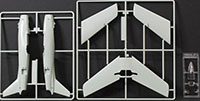
Academy 1/72 F-86F Sabre Kit First Look
By Michael Benolkin
| Date of Review | March 2017 | Manufacturer | Academy |
|---|---|---|---|
| Subject | F-86F Sabre | Scale | 1/72 |
| Kit Number | 12546 | Primary Media | Styrene |
| Pros | Easy build | Cons | Nothing noted |
| Skill Level | Basic | MSRP (USD) | $24.00 |
First Look
 |
 |
 |
The North American P-86 was a parallel development for the USAAF of the FJ-1 Fury for the US Navy. Both were straight winged aircraft that represented a turbine-powered P-51 Mustang tailored for airfield or carrier operations, respectively. While the US Navy took their straight-winged Furies into service, the USAAF found the performance of the P-86 lacking.
At the end of World War Two, North American received some useful engineering data captured from one of the Messerschmitt research sites regarding the Me 262 and its future derivatives. North American was able to adopt the research to add swept wings and aerodynamically operated leading edge slats to their Sabre, and the famous gunfighter was truly born. When the Korean War broke out and the first air combat was experienced against the MiG-15, the US Navy acquired a few swept-wing Sabres of their own to evaluate, leading to the production of their swept-winged Furies.
The F-86E introduced the all-flying tail to the Sabre series, while the F-86F adopted an upgraded J47 with better engine performance. Another improvement was the adoption of the "6-3" wing which referred to the standard F-86 wing that was six inches wider in chord at the wing root and three inches greater in span. The aerodynamic slats were removed and a wing fence added to improve flight performance and stability. Improved slats were added later to the "6-3" wing with the F-86F-40, while export versions also added an additional 12 inches of wingspan in addition to the improved slats.
Academy has reissued their 1/72 F-86F kit with some nice decal options. The kit is molded in medium gray styrene and presented on three parts trees plus one tree of clear parts. The kit features nicely scribed details and no flash. There are no ejector pin marks in any of the 58 parts. The four clear parts that comprise the canopy, gunsight glass and landing light are crystal clear.
Among the features and options:
- Nice cockpit and ejection seat
- Positionable canopy
- Positionable wing slats
- Positionable stabilators
- Positionable speed brakes
- External fuel tanks
Decals are provided for three different examples:
- F-86F-1-NA, 51-2897, 39 FIS/51 FIW, Suwon AB, Korea, 1953, 'The Huff', as flown by Lt. James L. Thompson
- F-86F-30-NA, 52-4584, 25 FIS/51 FIW, Suwon AB, Korea, 1951, 'MiG Mad Marine', as flown by Major John Glenn
- F-86F-5-NA, 51-2941, 16 FIS/51 FIW, Suwon AB, Korea, 1953, 'Little Rita', as flown by Lt. Dick Geiger
This is a nice kit for the AMS modeler as well as the less-experienced modeler as assembly is straightforward and with the variety of aftermarket items available, the AMS modeler can add detail as well as a nice bare metal finish to create a beautiful model.
My sincere thanks to MRC for this review sample!







